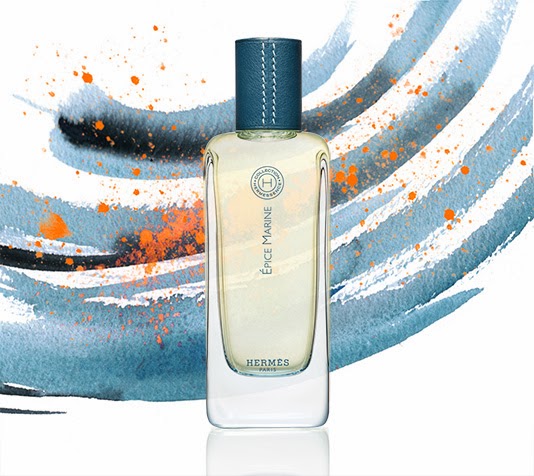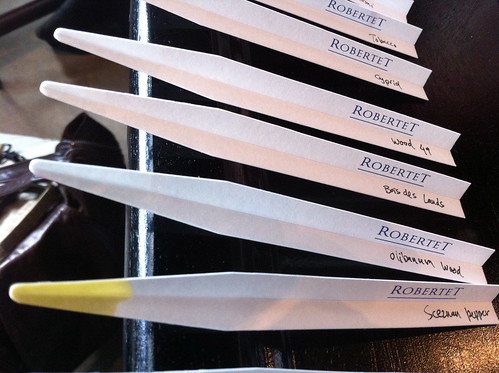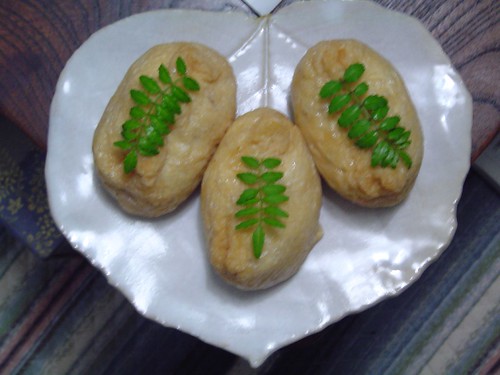Monday was spent on the road mostly, doing a round trip to Seattle to reconnect with the West Coast indie perfume community, and smell some new raw materials. The fresh Szechuan pepper essence pictured here made the trip worth my while, but there were some other fascinating raw materials worth writing about.
Elemodor: fraction of elemi resin, which possesses no resemblance to its origin, with only the slightest hint of resinous woody. The best way to describe it is as orange zest and juice on speed.
Elemi (Canarium luzonicum): Sharp, crisp, like lemon and black pepper combined, and also with hints of both cilantro leaf and pink peppercorns.
Tobacco absolute: Time and time again, I'm surprised at how muted tobacco is. It can easily disappear in a blend, and it sometimes seems as if the more you add, the less you'd smell of it. A challenging raw material to work with, but powerful and very elegant when used properly. Although it does not have a very strong odour intensity or diffusive power, it is a distinctive note, reminiscent of freshly cured tobacco leaves (read: not stale!), fermented hay in a meadow, and with an undercurrent of animalic energy. A truly good tobacco bring a sense of reverence and reminds me of the original use of this as a sacred, medicinal plant.
Please note that this absolute is nicotine free, unfortunately, so don't try this as a substitute for your nicotine patch!
Cypriol/Cyperus/Nagramotha (Cyperus scariosus): from the vetiver family, this root oil possesses as urpentie, sharp top note, woodsy-dry base, and a very clean, elegant dryout reminiscent of the hint of tart freshness of Haitian vetiver.
Bois des Lands or
Pinewood is a co-extraction of French pine resinoid with a Virginian cedarwood oil. Smells of wood, mushroom-y forest floor, moss and a tiny smoky, with a cheese-like fermented undertones. Dries out to a woody-balsamic finish.
Cedarwood fraction: From Texas cedarwood. Sharp cedar note, a little sweaty-herbaceous reminiscent of oregano.
Olibanum Wood: co-distillation of olibanum (frankincense resin) with Virginia cedarwood, which creates an interesting new note that is more stable and woody, more reminiscent of dusty frankincense tears rather than the oil or the smoke.
Vanilla CO2 with 20% vanillin: This is just about as sweet as one can get, in a very elegant way.
Ambrette Oil (Abelmoschus moschatos): High content of ambrettolide, resulting in a typical "white must" scent without the skin-like, buttery, nutty and wine-like quality of most ambrette seed essences.
Szechuan Peppercorn, Fresh: Green, floral, surprisingly citrusy (reminiscent of ruby red grapefruit, bergamot and yuzu), tomato leaf and yerbamate. Very distinct, fresh and tenacious.
Poplar Buds Absolute: Honeyed, boozy, hops-like, hint of cloves, dominant propolis note, hint of nutritional yeast odour.
Mimosa Olessence: Gentler extraction method, resulting in a more true to the flower profile. Reminiscent of almonds, marzipan, hints of fennel, floral, woody and clean.
Elderflower Absolute: That nutritional yeast note again, with only the tiniest hint of what the fresh flowers are all about - cassis-like and floral. More like hay than a flower overall. Similar to linden blossom absolute, which also presents a similar problem.
KF1150: Isolate that smells grassy green and sharp - like a combination of gasoline and freshly cut grass. Your dad is going to love this!
Black Tea Absolute: Smells like a wonderful container full of fresh Assam tea, maybe hints of Darjeeling too.
Eucalyptus Forte: Combination of of solvent extraction and molecular distillation. Green, balsamic, eucalyptus pods, hints of animalic/indolic quality, surprisingly. Very tenacious, resinous-woody-balsamic dryout.
Just a little glimpse into where a perfumer's palette can expand.
And that's all, folks!





